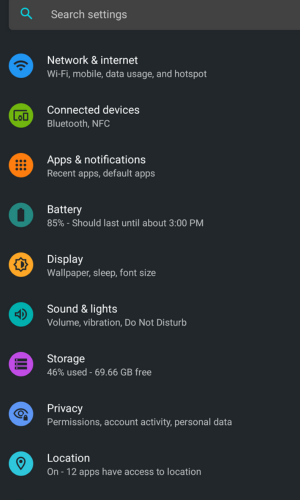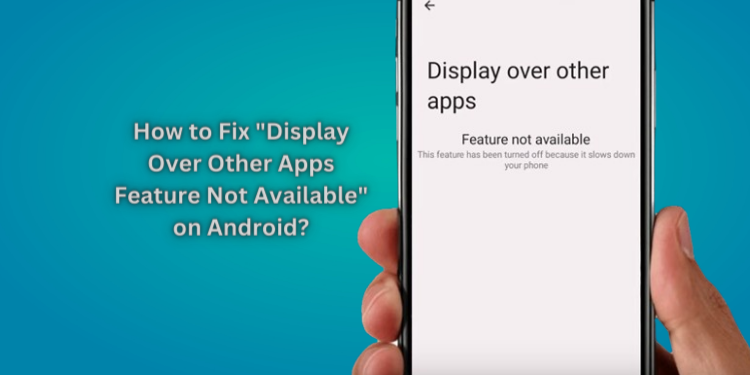Display Over Other Apps Feature Not Available [Fixed 2024]
Smartphone and mobile App users increasingly value the option to “display over other apps.” This feature lets some apps run on top of one another, making multitasking easier. Discover how to fix Display over other Apps feature not available on Android and find step-by-step solutions and troubleshooting tips to improve multitasking.
What Is the Display Over Other Apps Feature?
The “Display over other apps” feature, also known as “Draw over other apps” or “Screen overlay,” lets certain apps overlay their content on other Android apps. This feature is useful when you require rapid access to information or controls without switching programs.
Some examples of this feature’s seamless use include conversation heads in messaging programs like Facebook Messenger, floating navigation buttons, and screen recording notifications.
Common Reasons for the Unavailability of “Display Over Other Apps”

Before we solve the problem, let’s look at some common causes of the “Display over other apps feature not available” alert on Android:
Android Version Compatibility: This feature may not be available in all Android versions. It may not work on older Android versions or custom Android versions from specific manufacturers.
App Permissions: This feature may require special app permissions. It could only function properly by giving the feature the necessary rights.
Manufacturer Restrictions: Some manufacturers, such as Xiaomi, OnePlus, and Samsung, may change or limit the availability of “Display over other apps.” by changing Android’s native features.
Performance Issues: Android may block this feature if it slows down your smartphone.
Let’s fix this and enable Android’s “Display over other apps” function.
How to Turn on Display Over Other Apps Feature
Depending on your Android version and manufacturer, the “Display over other apps” function may be enabled differently. Below are the typical steps to enable this feature:
Step 1: Check Android Version Compatibility
Check whether your Android version supports “Display over other apps.” So how:
- Go to Device Settings.

- Select Apps & notifications or similar down below.

- Select Advanced.

- Click Special App access.

- Search for Display over other apps.

- If you find it, enable it.

- If not, your Android version may not support it.
Step 2: Grant Necessary App Permissions

Some apps require rights to enable if they turn off “Display over other apps.” How to grant them:
- Access device settings.
- Go to Apps & notifications.
- Select the App to enable the feature.
- Tap Permissions.
- Allow overlay or draw over other Apps.
Step 3: Device Manufacturer Settings
Samsung and Xiaomi devices may require you to enable this option in their settings. For precise instructions, consult your device’s user manual or search online.
Step 4: Performance Optimization
“Display over other apps” can affect device performance. Consider the following if you see big slowdowns or instability:
- Stop unwanted programs from using this feature.
- Install the latest Android version for speed improvements.
How to Fix Display Over Other Apps Feature Not Available on Android
Let’s go through the steps to configure the “Display Over Other Apps” option, which can be tricky:
Allow Screen Overlays in Settings
- Go to Settings.
- Scroll down to “About phone.”
- Tap “Version” several times to become a developer.
- Enter your password if asked.
- Go to Settings, click “System,” then choose “Developer options.”
- Switch on “Allow screen overlays.”
Re-enable the Feature for a Specific App (Android GO)
- Tap “About.” in Settings.
- Tap “Build Number” twice to enable developer mode.
- In Developer, enable “USB Debugging.”
- Now, use ADB on your computer:
- Download and extract ADB files.
- Run a command prompt in the folder.
- Use USB to connect Android phone to computer.
- Type “adb devices” and enter.
- Type “adb shell pm grant <package-name> android.permission.SYSTEM_ALERT_WINDOW” (replace with the App’s package name) and press Enter.
Turn on Screen Overlay for the App
- Settings > Apps > Configure > App Permissions.
- Manually enable “Display over other apps.”
These procedures should fix Android’s “Display Over Other Apps Feature Not Available” issue. If problems persist, contact App support or the Android community.
Troubleshooting “Display Over Other Apps” Issues
If the “Display over other apps feature not available” message still shows up after you’ve done the steps above, try the following troubleshooting tips:
Restart Your Device: Restarting your device typically fixes minor software issues.
Check App Updates: Update the App you want to use with this functionality. Many developers offer updates to fix compatibility issues.
Factory Reset: Resetting your device to factory settings is an option you can use only if all else fails. Before continuing, back up important information because this will delete all device data.
Contact Manufacturer or Support: Contact your manufacturer’s customer service if the problem persists and is device-specific.
FAQs
How do I unlock my Display Over Other Apps?
In your device’s settings, click “Apps,” select the App, and enable “Display Over Other Apps.”
What is a screen overlay setting?
Android screen overlay lets programs display content or controls over other apps. This is used for chat heads, floating widgets, and drawing over other programs.
Is overlay permission safe?
Overlay permissions improve app functioning and are safe. Be cautious and allow only trusted apps.
Conclusion
Android’s “Display over other apps” functionality lets programs overlay their content on top of one another, improving multitasking and ease. However, the “Display over other apps feature not available” can aggravate.
You may troubleshoot and enable this function on your Android device by following this guide and considering compatibility, permissions, and performance. Please consult your device’s user manual or manufacturer’s support pages for device-specific variances and limits.


![What is AVC Block List? [How to Turn off it 2024]](https://techswow.com/wp-content/uploads/2023/12/Untitled-design3-3.webp)
![How To Apply Update From ADB? [6 Easy Steps 2024]](https://techswow.com/wp-content/uploads/2023/12/Apply-Update-from-ADB-Samsung-Devices.jpg)
![Crunchyroll Unauthorized Request [Fixed 2024]](https://techswow.com/wp-content/uploads/2024/01/Crunchyroll-Unauthorized-Request.webp)
![What is Cameralyzer Samsung? [How to Uninstall it 2024]](https://techswow.com/wp-content/uploads/2023/12/What-is-Cameralyzer-Samsung.webp)